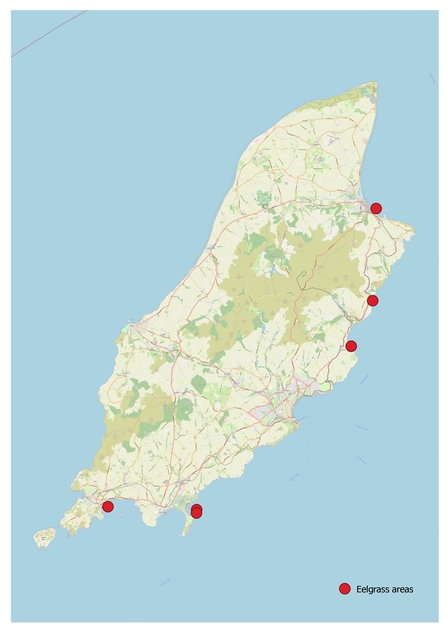
Map of the Manx eelgrass sites
Seagrass, also known as Eelgrass, grows in lush underwater meadows at various sites around the Island, predominantly in sheltered sites on the east coast. It’s a flowering plant rather than a seaweed, supporting a range of food webs and sea creatures including commercially important fish nurseries.
This tiny plant could also be part of the solution to the climate emergency with its ability to capture large amounts of carbon from the atmosphere and lock it away in the seabed - it can store carbon 35 times faster than a tropical forest!
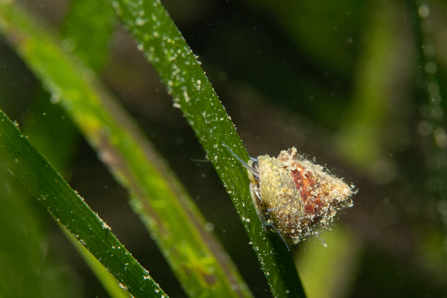
Grooved Topshell on eelgrass - Lara Howe
It is protected under OSPAR and the Isle of Man Wildlife Act. Conserving and potentially restoring Eelgrass is important for the Island Blue Carbon Plan and Climate Change Plan. We are working hard to understand the threats to this unique habitat, and to begin to conserve and even restore these meadows.
Decline
After centuries of industrialisation and overexploitation many eelgrass meadows have been left barren. In the 1930’s a wasting disease eliminated or drastically reduced many seagrass beds around the British Isles, but recovery on the Island was hampered by a few factors. Sewerage outfalls lead to nutrification of water and scallop dredging effectively ploughs the seabed removing the eelgrass. For many years eelgrass has been restricted to tiny colonies such as between St Michael’s Island and Langness.
In the last 40 years, we’ve lost one third of eelgrass meadows globally.
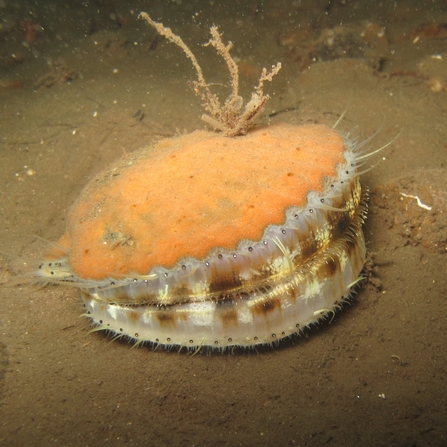
Queen scallops are commercially fished using dredging techniques.
Polly Whyte / Earth In Focus
Recovery
From 2004 the Island’s new sewerage treatment works started to clean up our waters and in 2011 Ramsey Bay became the Island’s first Marine Nature Reserve. The recovery of eelgrass was soon starting to be recorded by divers and by systematic surveys.
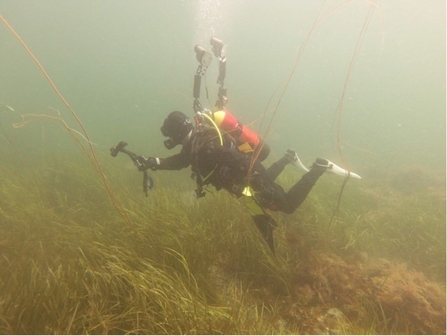
A diver surveying an Eelgrass bed off Fort Island
Richard Cowin
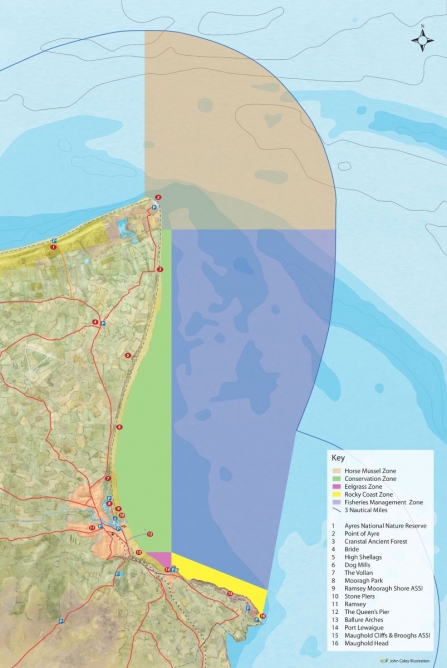
Ramsey Bay Marine Nature Reserve
Eelgrass is now being recorded from many east coast sites as a natural recovery begins. Walk along Ramsey beaches after a storm and you are very likely to see clumps of seagrass washed up. This is a sure sign of large healthy populations further out to sea. It is likely that much of the recovery was from small relic populations, but it is also possible that there has been natural colonisation too.
The future could be sea-horses?
Eelgrass still has a way to go to recolonise all of its historic Manx sea beds and some of this colonisation will be natural, but Manx Wildlife Trust has trialled translocating seagrass to area in Port Erin Bay, a project funded by Microgaming.
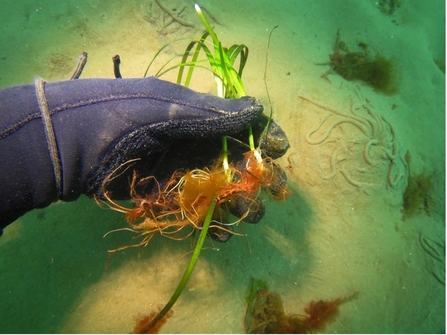
An eelgrass sprig about to be planted in Port Erin Bay
Richard Cowin
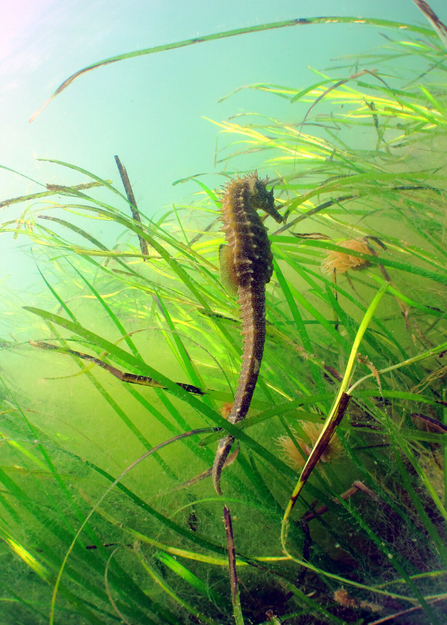
Seahorse in eelgrass, could this be our future?
Paul Naylor
With climate change comes a warming of the sea and a gradual northwards movement of marine life. Seahorses are the most enigmatic eelgrass meadow species and are presently recorded as far north as South Wales. In coming decades a northward expansion is likely and colonisation of the Isle of Man may one day occur.
Carbon and seagrass
Eelgrass has an extensive root system to hold fast to sandy sea-beds. The natural turn-over of roots and leaves dying and growing in the sand creates organic stored carbon and when the seagrass meadows become fully established they also trap and ultimately bury organic rich sediments. Eelgrass meadows will continue to sequester carbon for as long as they are not disturbed.
Accurate figures for how much carbon is actually stored annually in seagrass beds is still under research, but figures are likely to be similar to functional upland peat-bogs.
Seagrass bed - Tony Glen
Eelgrass and MWT
In addition to the translocation work in Port Erin bay, MWT and volunteer divers from Seasearch have formed the Manx Eelgrass Group (MEG). MEG will map the existing eelgrass beds and any new beds that have been identified around the Manx coastline. This will quantify the eelgrass and record species and their abundance. This work is closely linked with DEFA’s Blue Carbon Project and is supported by KPMG.
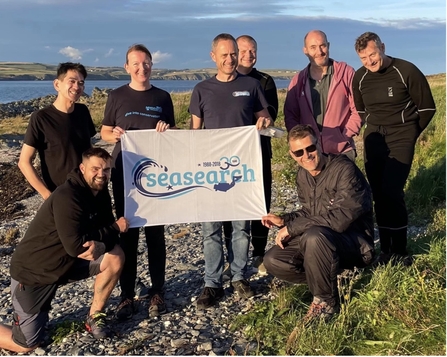
A survey team at Fort Island, Langness.
Much is still unknown about the Island’s Eelgrass and the Manx Eelgrass Group aims to plug key knowledge gaps by:
- Monitoring and mapping of eelgrass, with drop-down cameras, divers and baited remote underwater video (BRUV)
- Conservation of existing eelgrass
- Possible restoration of sites
- Recommending future work
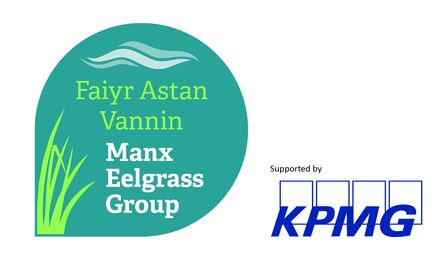
UN Sustainable Development Goals
The group aligns to 2 of the United Nations 17 Goals to Transform Our World
The Sustainable Development Goals are a call for action by all countries – poor, rich and middle-income – to promote prosperity while protecting the planet.
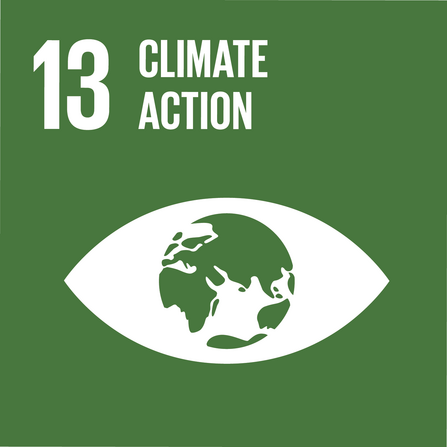
Taking urgent action to combat climate change and its devastating impacts is an imperative to save lives and livelihood.
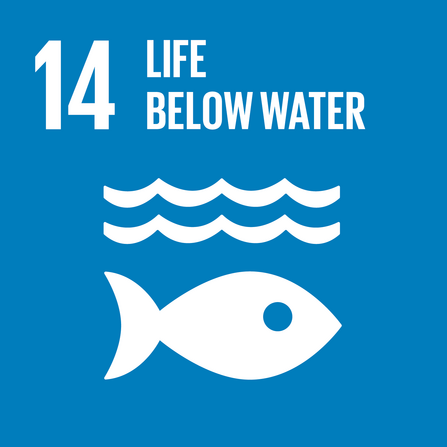
Healthy oceans and seas are essential to human existence and life on Earth.
News
Eelgrass in the news! Find some of the latest research and news stories here:
- https://www.gov.uk/government/news/englands-largest-ever-seagrass-planting-hits-new-milestone--2
- https://www.wwf.org.uk/success-stories/seagrass-restoration-project
- https://www.theguardian.com/environment/2021/mar/04/catastrophic-uk-has-lost-90-of-seagrass-meadows-study-finds
- https://www.countrylife.co.uk/nature/the-seagrass-meadows-around-britain-one-of-the-most-valuable-and-biodiverse-habitats-on-the-planet-248456
Project Partners

